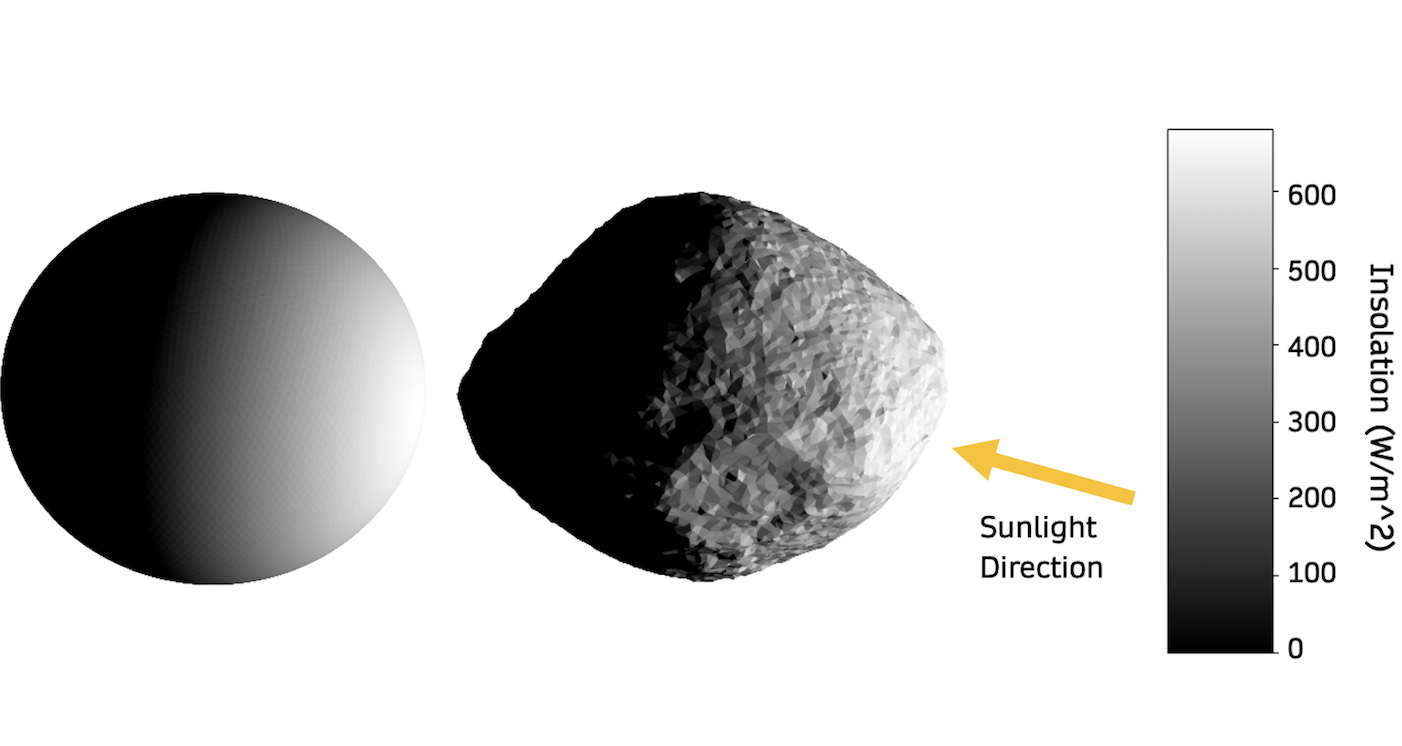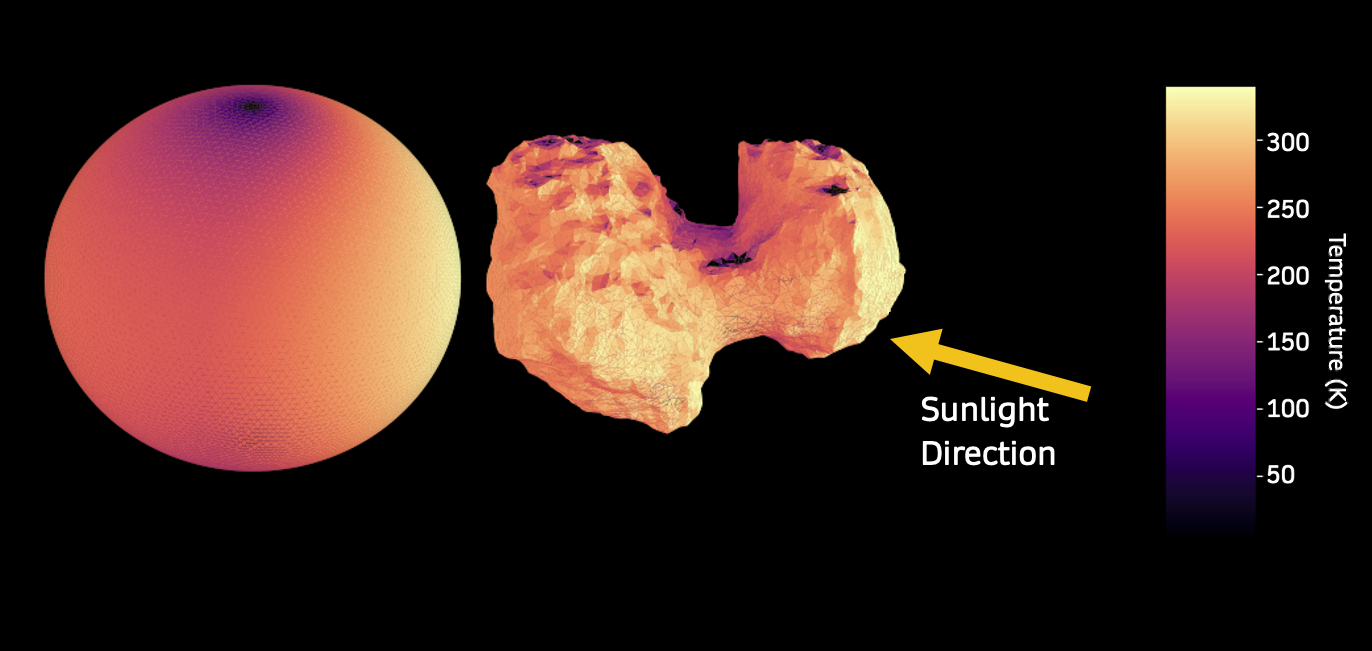Predicting Surface Temperatures on Airless Bodies: An Open-Source Python Tool
- University of Oxford, Department of Physics, Atmospheric, Oceanic, and Planetary Physics, United Kingdom of Great Britain – England, Scotland, Wales (duncan.lyster@physics.ox.ac.uk)
Abstract:
Understanding the thermal properties of comets, asteroids, and icy moons is crucial for advancing our knowledge of their composition and evolution. An increasing number of missions to these bodies, including Rosetta, Osiris-Rex, Europa Clipper, and JUICE, necessitate thermal models that accurately consider their complex topographies.
We have developed a Python model that predicts diurnal temperature variations on airless bodies in three dimensions, factoring in their morphologies. This model significantly improves simulation accuracy by incorporating shadowing effects. The results are consistent with established models such as the one-dimensional thermal conduction model of J.R. Spencer, thermprojrs [1], and the three-dimensional surface energy balance model by Guilbert-Lepoutre & Jewitt [2].
Our tool was built to support missions such as the NASA Lucy Mission and the ESA Comet Interceptor mission. However, it is suited to a wide range of targets, including those with active surfaces. The model is user-friendly and operates quickly, running in seconds for basic shape models, and requiring only a few minutes for a shape model of comet 67P with 16,000 facets. It is designed to handle subsurface heating efficiently and is parallelised, enabling applications to large, high spatial resolution shape models.
Background:
The thermal behaviour of airless planetary bodies is governed by their surface and subsurface properties, including albedo, surface roughness, and thermal inertia. Accurate thermal models are essential for interpreting observational data and planning missions. Traditional models, such as Spencer's thermprojrs, have provided valuable insights into the thermal evolution of these bodies by simulating one-dimensional heat conduction. These models are instrumental in understanding the diurnal and seasonal temperature variations on the surface.
However, the complexity of three-dimensional topographic features, such as craters, ridges, and boulders, necessitates more advanced modelling techniques. While existing three-dimensional models have addressed some of these complexities, there remains a need for accessible, high-resolution models to simulate and interpret thermal data from current and upcoming missions accurately.
Outline of the Model:
Our open-source Python-based model aims to fill this gap by providing a comprehensive tool that can account for three-dimensional morphological features and shadowing effects. This model enhances the accuracy of temperature predictions and makes advanced thermal modelling techniques available to a wider scientific community. The integration of this model with thermal mapping data from missions can further refine shape models, leading to improved interpretations of the thermal properties of airless bodies.
The model solves a surface energy balance equation for each facet of the shape model file. This equation factors in solar heating, radiative loss, thermal conduction, and subsurface heating. The result is a temperature map that evolves over time, providing insights into the diurnal cycle and the thermal properties of the target body under various conditions.
This approach is efficient and user-friendly, requiring only a few minutes to process a shape model with thousands of facets. The model's parallelised nature allows for rapid computation, making it suitable for extensive simulations and analyses.
Validation Work:
To validate our model, we compared its output with the results from Spencer's one-dimensional model. As shown in Figure 1, the temperature versus time profiles from both models show close agreement, with slight differences attributed to the handling of deep layer temperatures.
Figure 1: Temperature vs Time for a single facet. Comparison between Spencer model and our model.
The model has been tested on various shape models, including comet 67P and the asteroid Bennu. The inclusion of shadowing effects, enhances the accuracy of temperature predictions in areas with significant topographic variation (Figure 2).

Figure 2: 3D illumination model with shadowing effects for shape models of a sphere, Bennu, and 67P.
The thermal map generated by our model (Figure 3), highlights the temperature distribution across the surface. These maps are essential for understanding the thermal evolution of the target bodies and planning mission operations. This model could also be used in tandem with thermal mapping data from missions to refine shape models, enhancing the accuracy of the thermal simulations and providing more detailed insights into the surface properties of the target bodies.

Figure 3: Thermal map showing temperature distribution on a sphere, Bennu, and 67P.
Conclusion:
Our open-source Python model represents an improvement in the simulation of thermal behaviour on airless planetary bodies. It provides accurate temperature predictions by incorporating three-dimensional surface features and shadowing effects. The model runs efficiently and can be parallelised, making it suitable for a wide range of applications, including realistic instrument simulations and mission planning.
Planned improvements to the model include implementing radiative self-heating, scattering of incident light, and energy loss through sublimation. Extensive parameter sensitivity analysis will further enhance the model's applicability to diverse targets.
The code is open source, and contributions are welcome:
github.com/duncanLyster/comet_nucleus_model
References:
- Spencer, J.R., Lebofsky, L.A., and Sykes, M.V., 1989. Systematic biases in radiometric diameter determinations. Icarus, 78(2), pp.337-354.
- Guilbert-Lepoutre, A., and Jewitt, D., 2011. Thermal shadows and compositional structure in comet nuclei. The Astrophysical Journal, 743(1), p.31.
How to cite: Lyster, D., Howett, C., and Penn, J.: Predicting Surface Temperatures on Airless Bodies: An Open-Source Python Tool, Europlanet Science Congress 2024, Berlin, Germany, 8–13 Sep 2024, EPSC2024-1121, https://doi.org/10.5194/epsc2024-1121, 2024.